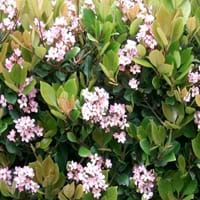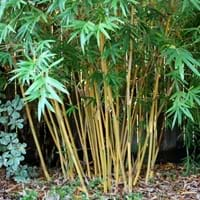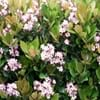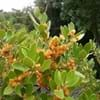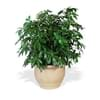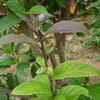Life Span
Annual and Perennial
Perennial
Type
Broadleaf Evergreen
Grass
Origin
Eastern Asia
China
Types
Not Available
Not Available
Habitat
gardens, Roadsides, Urban areas, Waste areas
Dry Forest, hedge rows, open Woodlands, Shady Edge
USDA Hardiness Zone
Not Available
8-15
AHS Heat Zone
Not Available
12 - 1
Sunset Zone
21,22
Not Available
Habit
Oval or Rounded
Clump-Forming
Minimum Height
Not Available
Flower Color
White, Red, Pink
Not Available
Flower Color Modifier
Bicolor
Bicolor
Fruit Color
Blue, Purple, Dark Blue, Blue Violet, Black
Not Available
Leaf Color in Spring
Green, Orange, Dark Green, Bronze
Light Green, Dark Green
Leaf Color in Summer
Green, Dark Green
Light Green
Leaf Color in Fall
Green, Dark Green
Light Green, Dark Green
Leaf Color in Winter
Green, Dark Green
Light Green, Dark Green
Plant Season
Spring, Summer, Fall, Winter
Spring, Summer, Fall, Winter
Sunlight
Full Sun, Partial Sun
Full Sun, Partial Sun, Partial shade
Type of Soil
Clay, Loam, Sand
Loam, Sand
The pH of Soil
Acidic, Neutral
Acidic, Neutral, Alkaline
Soil Drainage
Well drained
Average
Bloom Time
Early Spring, Spring, Late Spring, Early Summer, Summer, Winter, Late Winter
Not Available
Tolerances
Drought, Salt
Drought
Where to Plant?
Ground, Pot
Container, Ground
How to Plant?
Seedlings, Stem Planting
Budding, From Rhizomes, Seedlings
Plant Maintenance
Medium
Medium
Watering Requirements
Keep ground moist, Requires watering in the growing season, Water when soil is dry
Average Water Needs
In Summer
Lots of watering
Lots of watering
In Spring
Moderate
Moderate
In Winter
Average Water
Average Water
Soil pH
Acidic, Neutral
Acidic, Neutral, Alkaline
Soil Type
Clay, Loam, Sand
Loam, Sand
Soil Drainage Capacity
Well drained
Average
Sun Exposure
Full Sun, Partial Sun
Full Sun, Partial Sun, Partial shade
Pruning
Cut or pinch the stems, Prune if you want to improve plant shape, Requires very little pruning, Shape and thin as needed
No need to prune
Fertilizers
All-Purpose Liquid Fertilizer
All-Purpose Liquid Fertilizer
Pests and Diseases
Fungal Diseases, Insects
Red blotch
Plant Tolerance
Drought
Cold climate, Drought, Heat Tolerance, Wet Site
Flower Petal Number
Not Available
Single
Edible Fruit
Not Available
No
Foliage Texture
Medium
Medium
Foliage Sheen
Glossy
Matte
Attracts
Bees, Birds, Butterflies
Butterflies
Allergy
no allergic reactions
Not Available
Aesthetic Uses
Beautification, Bonsai, Showy Purposes
Showy Purposes
Beauty Benefits
Not Available
No Beauty Benefits
Environmental Uses
Air purification
Air purification, Food for insects, Wildlife
Medicinal Uses
No Medicinal Use
Not Available
Part of Plant Used
Flowers
Stem, Tree trunks
Other Uses
Showy Purposes, Used as Ornamental plant
Economic Purpose, Traditional medicine, Used As Food, Used for woodware, Used in Furniture, Used in paper industry
Used As Indoor Plant
Sometimes
No
Used As Outdoor Plant
Yes
Yes
Garden Design
Container, Feature Plant, Foundation, Hedges, Houseplant, Mixed Border, Topiary, Bonsai, Espalier
Container, Feature Plant, Hedges, Screening / Wind Break, Tropical
Botanical Name
RHAPHIOLEPIS
BAMBUSA multiplex
Common Name
Indian hawthorn
Clumping Bamboo, Hedge Bamboo
In Hindi
भारतीय नागफनी
हेगड़े बांस
In German
indische Hawthorn
Hedge Bambus
In French
Indian Hawthorn
Bamboo Hedge
In Spanish
Indian Hawthorn
bambú de cobertura
In Greek
Ινδικό Hawthorn
hedge Μπαμπού
In Portuguese
indiana Hawthorn
Bamboo Hedge
In Polish
Indyjski Hawthorn
Żywopłoty Bamboo
In Latin
Latin Hawthorn
Sepi Bamboo
Phylum
Tracheophyta
Magnoliophyta
Class
Magnoliopsida
Liliopsida
Genus
Rhaphiolepis
Bambusa
Clade
Angiosperms, Eudicots, Rosids
Angiosperms, Commelinids, Monocots
Subfamily
Amygdaloideae
Bambusoideae
Number of Species
Not Available
Season and Care of Indian Hawthorn and Hedge Bamboo
Season and care of Indian Hawthorn and Hedge Bamboo is important to know. While considering everything about Indian Hawthorn and Hedge Bamboo Care, growing season is an essential factor. Indian Hawthorn season is Spring, Summer, Fall and Winter and Hedge Bamboo season is Spring, Summer, Fall and Winter. The type of soil for Indian Hawthorn is Clay, Loam, Sand and for Hedge Bamboo is Loam, Sand while the PH of soil for Indian Hawthorn is Acidic, Neutral and for Hedge Bamboo is Acidic, Neutral, Alkaline.
Indian Hawthorn and Hedge Bamboo Physical Information
Indian Hawthorn and Hedge Bamboo physical information is very important for comparison. Indian Hawthorn height is Not Available and width Not Available whereas Hedge Bamboo height is 460.00 cm and width Not Available. The color specification of Indian Hawthorn and Hedge Bamboo are as follows:
Indian Hawthorn flower color: White, Red and Pink
Indian Hawthorn leaf color: Green, Orange, Dark Green and Bronze
Hedge Bamboo flower color: Not Available
- Hedge Bamboo leaf color: Light Green and Dark Green
Care of Indian Hawthorn and Hedge Bamboo
Care of Indian Hawthorn and Hedge Bamboo include pruning, fertilizers, watering etc. Indian Hawthorn pruning is done Cut or pinch the stems, Prune if you want to improve plant shape, Requires very little pruning and Shape and thin as needed and Hedge Bamboo pruning is done No need to prune. In summer Indian Hawthorn needs Lots of watering and in winter, it needs Average Water. Whereas, in summer Hedge Bamboo needs Lots of watering and in winter, it needs Average Water.
